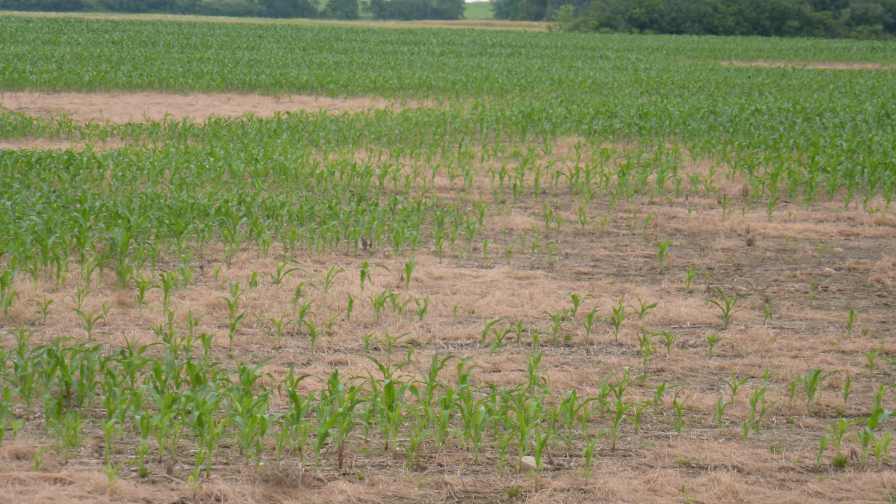Understand What Your Soil Test Means to Make Better Management Decisions

In a wet year, reduced wet aggregate stability causes poor percolation of rainwater and severe reduction in crop growth. Aggregate stability is promoted by building active carbon, often by adding a cover crop and by reducing tillage. Photo credit: Thomas Bjorkman, Cornell University
To make decisions on management practices to produce the healthiest crops possible, you need to understand what your soil test means. New, or perhaps more accurately, newer, soil tests provide pertinent information about a soil’s health in ways that will allow you to change management practices to remove restricting conditions.
Cornell University’s Soil Health Testing Laboratory’s Comprehensive Assessment of Soil Health (CASH) test is one way for you to better understand the health status of your soil. The test is said to be the first commercially available laboratory soil health test that provides standardized, field-specific information on soil biological and physical processes in addition to the conventional nutrient analysis.
Assessment indicators and management strategies for improving your soil are available in the latest version of Cornell’s manual, “Comprehensive Assessment of Soil Health – The Cornell Framework,” which is available for free download at http://soilhealth.cals.cornell.edu/training-manual/. The soil health test has been available since 2006, but Thomas Bjorkman, Associate Professor of vegetable crop physiology at Cornell University, says updates have been made to the tests that are quicker and more cost effective.
“These tests let you know what aspects of soil tilth need management attention in order to maintain the productivity of your land,” Bjorkman explains. “While many growers feel the soil in their hand (or even smell and taste it), the biological and physical quality of the soil has still declined. A lot of on-farm research has shown, and participating growers have recognized, that instrumental tests of this important soil quality results in more effective management decisions.”
Soil Health Measurements
The standard soil health assessment involves eight physical and biological indicators: soil texture, wet aggregate stability, available water capacity, soil strength, organic matter, active carbon, soil respiration, and the soil protein index in addition to the conventional chemical analysis. Bjorkman and Aaron Ristow, an Extension Associate in the Soil and Crop Health Section at Cornell, who are both involved with the Soil Health Testing Laboratory, define these indicators and shed some light on the how they will help you better serve your soil and your crops.
Soil Texture
A soil’s solid material is generally comprised of various-sized mineral particles, which make up the texture. The textural class is defined by the relative amounts of sand, silt, and clay, according to the Soil Health manual.
Wet Aggregate Stability
Wet aggregate stability calculates how well soil aggregates are held together by organic glues, most of which were formed by rhizosphere microbes, Bjorkman explains.
A well-aggregated soil has more air spaces for roots to grow, Ristow adds. It also has more air spaces to supply air to respiring microbes, for excess water to percolate, and for water to be held in the matrix where crops can use them.
Available Water Capacity
Available water is the quantity of water that a disturbed sample of soil can store for plant use, and is measured using pressure chambers.
Soil Strength
Soil strength or surface hardness is a measure of compaction that develops when large pores are lost in the surface soil, which comprises up to 6 inches. To measure compaction, use a penetrometer, the manual recommends.
Organic Matter
This is a measure of all carbon-related material that comes from living organisms.
Active Carbon
Active carbon calculates how much food is available for soil microorganisms, which is a small subset of the total organic matter in the soil, Bjorkman explains.
“In vegetable production, the amount of carbon returned to the soil tends to be much less than what is used each year,” Bjorkman adds. “Furthermore, the frequent tillage depletes the active carbon more quickly than many other production systems, such as the practice of resting the soil for a few years while letting grass species grow the traditional way to restore active carbon.”
Soil Respiration
This is a measure of soil-microbe activity. The respiration value can vary over time or rotations, but, Bjorkman says, in general, is high if the soil microbes are fed.
For example, if respiration is determined to be too low, it is a good idea for the grower to develop a program that will free those microbes. “That program is usually based on producing more organic matter that stays in the field to feed the soil microbes and make the soil come alive,” Ristow says.
Soil Protein Index
The soil protein index determines the nitrogen that is available for mineralization. This available nitrogen can be a significant contributor to crop nitrogen needs, according to Bjorkman.
Many have become proficient in determining nitrogen fertilizer requirements, however, the problem lies in figuring out soil nitrogen release.
“Predicting soil nitrogen release has been so difficult that many simply disregard the nitrogen credit from the soil,” Bjorkman explains. “But everyone who has substantial nitrogen release from the soil notices how much more resilient the crop is to the vagaries of weather, especially if soil conditions prevent timely nitrogen application or denitrification removes it.”










